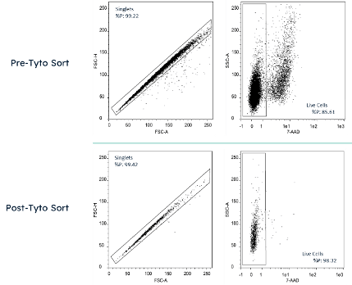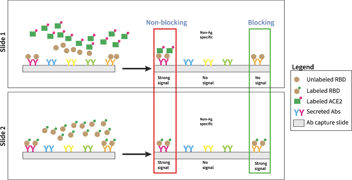SurfScreen Pilot for TIGIT
The Challenge
- Screening for antibodies against membrane targets to confirm antibody binds to native conformation of the target
- Can also be applied to complex membrane targets (GPCRs, ion channels)
The Single Cell Solution
- Develop a cell-binding module to assay antibodies binding to target-expressing cells
- Keep flexibility of including recombinant screens, when needed
Highlights
- Screening for antibodies that bind target-expressing cells
- Include recombinant screens to layer even more data
Problem: Taking on the Challenge
Demonstrate ability to screen antibodies against membrane targets, a high-value capability in antibody discovery.
Incorporate SurfScreen and SimulScreen together
Solution: Finding a Better Way
SurfScreen is a new screening mode in AbTheneum™ capable of addressing membrane-bound targets. We align 2 picowell devices together – yes, all 90,000+ wells – to allow antibodies to interact with the membrane-bound target on the cells. Then, we separate the 2 devices, detect and image the bound antibodies.
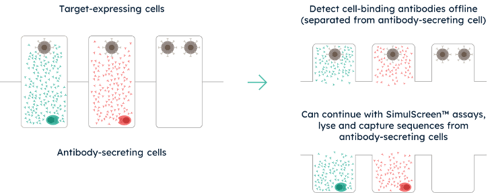
In this case study, plasma cells were isolated from TIGIT-immunized wild-type mice and loaded onto our picoliter device.
On a separate picoliter device, we overloaded TIGIT-expressing cells. We aligned and incubated the 2 devices together to allow the antibodies secreted from the plasma cells to interact with the TIGIT-expressing cells.
Once incubation was complete, we separated the 2 devices and imaged the TIGIT-expressing cells to detect antibodies bound to the membrane using a fluorescent secondary antibody.
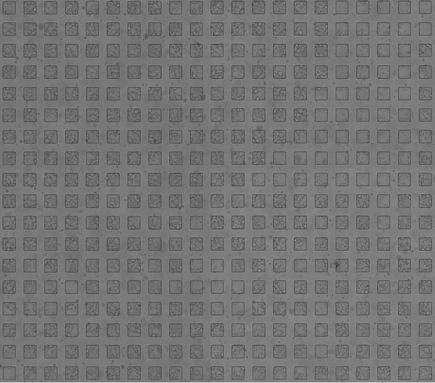
Overloaded TIGIT expressing cells in brightfield
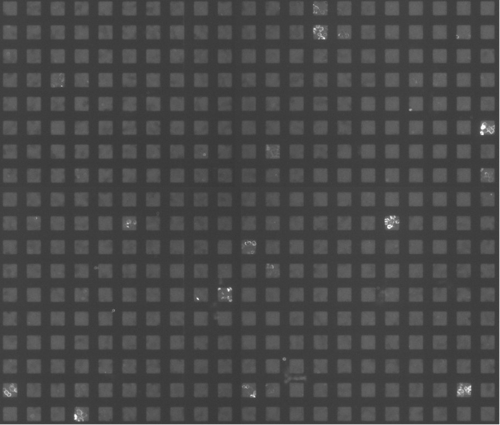
Overloaded TIGIT-expressing cells in fluorescent channel, showing some wells have mouse antibody bound to the membrane.
On a cell-by-cell basis, we see some wells had cell-binding antibodies that were cross-reactive, some wells had cross-reactive antibodies that don’t bind cells, and some cell-binding antibodies are not cross-reactive.
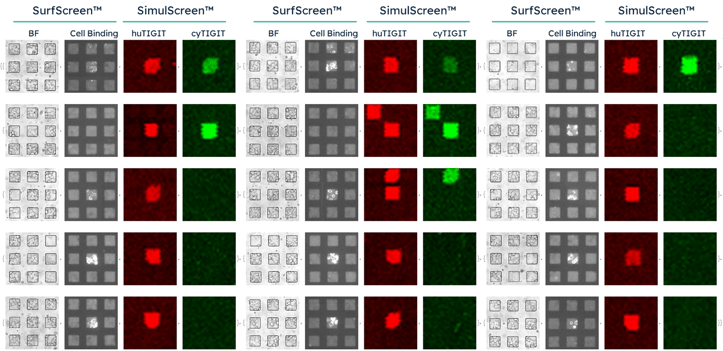
Data output from monoclonal antibodies from a single picowell. Each picowell generated a set of 4 images showing TIGIT-expressing cells in brightfield, cell-binding antibodies detected on TIGIT-expressing cells, SimulScreen data from captured antibodies showing binding to human TIGIT, and SimulScreen data from captured antibodies showing binding to cynomolgus TIGIT.
This project used a recombinant extracellular domain (ECD) of TIGIT to immunize the mice, and it is common that antibodies derived from that type of immunogen do not always bind to the cell membrane. We do see examples of that, and we see examples of cell-binders that are not cross-reactive.
Outcomes: Moving the Campaign Ahead
-
SurfScreen can screen antibodies against targets expressed on cells.
-
SurfScreen could be applied to complex multipass transmembrane targets such as ion channels and G-protein coupled receptors (GPCRs)
-
SurfScreen can be run in parallel to SimulScreen assays, if there are recombinant versions of the protein that can be used
-
Sequence capture for SurfScreen is the same as all other AbTheneum projects, due to keeping antibodies separate from antibody-secreting cells

